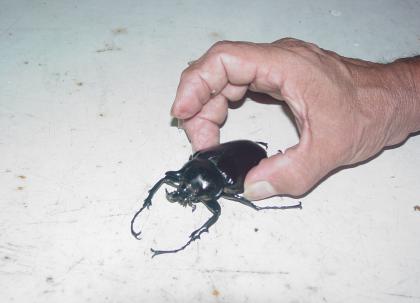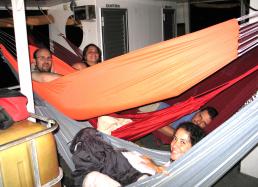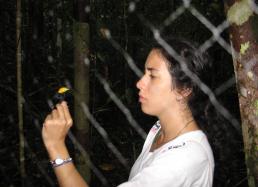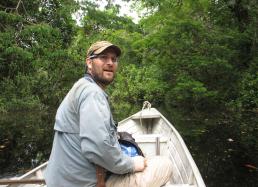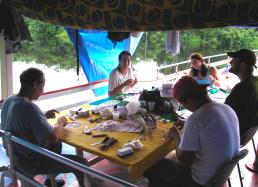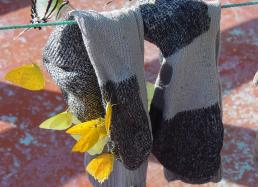Blog #4: Daily Life
Daily life in the field is pretty cushy when you’re living on a boat. In a field camp located on land, we’d have to deal with rain, mud, many more insects (although plenty have colonized the boat by climbing along the ropes that tether the boat to shore—see the above photo), and unpacking and packing every time we moved to a different field site. The beauty of the boat is that we have our own mobile field camp.
Morning starts early, usually before dawn, with most of us waking up anywhere from 4:30 - 5:30 a.m., depending on how far from the boat we’re going (see Photo #1 below.) I have to say that I’m not the fastest in the morning, and if it weren’t for the amazing birds in the forest, I’d sleep in every day!
Anyway, after waking up and getting dressed, we all meet up on the lower deck to grab some breakfast and coffee and to fill our water bottles for the morning onshore. Breakfast varies; sometimes we eat cream crackers with butter, and other times our cook makes us more elaborate treats. One day she made us delicious, little, deep-fried powdered “donuts.”
Ideally we leave the boat before first light, wearing our headlamps as we hike into the forest to catch the dawn chorus. Many birds will sing only during these early hours, so it’s important to get out there before the crack of dawn. Some of the team open nets (see Photo #2 below), others walk trails while searching for birds, and in a few days, once we’ve worked in the Terra Firme a bit, two team members will use a voadeira (rowboat) to survey birds along the river and in the flooded forest (see Photo #3 below.)
Around 11 a.m. or 12 noon, we close up the mist nets and all of us head back to the boat. Nearly all of us take a quick shower before eating lunch, prepared by the boat’s cook. Our twice-a-day meals include rice and beans and farinha de mandioca (manioc flour). I love eating rice, beans, and farinha; it has to be one of the best food combinations out there for hard field work.
After lunch, we all pick a spot around the work table and start preparing bird skins and sampling specimens for parasites (see Photo #4 below.) Each specimen takes about an hour to prepare, and we typically work until 11 p.m. or midnight. Just prior to bedtime, we all sit down together and compare notes to compile a comprehensive count of bird species heard and seen throughout the day, which will be used to create a master list of all of the bird species found at each of the localities that we’re visiting.
One by one, we take turns jumping in for a second shower to rinse off before heading to our hammocks for a good night’s sleep. As I stretch out to sleep, I spot a large and venomous Armadeira Wandering Spider (Phoneutria sp.) strolling on the ceiling. Picture a spider the size of an NBA players hand crawling above your head...it doesn’t make falling asleep easy! I have to admit that at times, some of the huge spiders kind of creep me out, and if you’re insect phobic, Amazonia would be a tough place for you.
Regardless of the creepy insects, there are so many fantastic moths, butterflies, leaf hoppers, beetles, etc...the diversity is amazing (see photos of some fabulous butterflies below!)
More soon,
Jason
